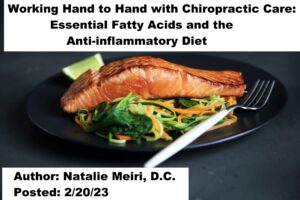
A Chiropractor in West Palm Beach can help you with many ailments by way of adjustments. However, the food you consume on a daily basis has a very large impact on your body and the thousands of underlying processes that go on inside it every day. Nutrition is certainly a significant factor in your health. So some of your lifestyle choices outside of the doctor’s office can influence the effectiveness of treatment. When you eat well, your immune system fights off illness better, you elevate your brain function, you lose weight and your energy soars. By incorporating certain foods into your diet, you can contribute to faster healing and continued wellness.
In this post we will look at the “Leaky Gut Syndrome”.
What is the “Leaky Gut” Syndrome?
“Leaky gut syndrome” is said to have symptoms including bloating, gas, cramps, food sensitivities, and aches and pains. Moreover, the “leaky gut” theory may explain the mechanism of many autoimmune diseases. In autoimmune diseases such as Multiple Sclerosis, Systemic Lupus Erythematosus (SLE), Ankylosing spondylitis (AS) and Inflammatory Bowel Diseases (IBD) (e.g. Crohn’s disease (CD) and ulcerative colitis (UC)), molecular mimicry (molecular similarity) and a “leaky gut” may activate an autoimmune response in the body.
Hence, Molecular mimicry or “molecular similarity” is an important concept in immunology. What happens is “external antigens” that resemble some “self-antigens” will lead to an immune response which will cause tissue damage to your body. And this is called autoimmunity. An antigen is a toxin or other foreign substance which induces an immune response in the body. Specifically and especially the production of antibodies.
What are some external antigens?
External antigens would be certain undigested food particles mimicking the self-antigen such as collagen (human protein), and eliciting an autoimmune response. For instance, bovine serum albumin (BSA) found in cow’s milk may be considered by the body as an antigen, and given that it is similar in sequence to human collagen, may cause an autoimmune reaction. Next is glycine protein found in grains and legumes, which has a similar protein sequence to connective tissue.
Other possible foods considered by your body as an antigen are: wheat germ agglutinin found in wheat, phytohaemagglutinin found in kidney beans and peanut lection found in peanuts. Moreover, you may be more genetically susceptible to this autoimmune reaction.
In summary, autoimmune disease occurs when the immune system produces autoantibodies against self-antigens, causing assault on body tissue. And an association of autoimmune diseases and leaky gut is wherein the leakage of pathogens (germs) into the body system results in autoimmunity.

In detail: Leaky Gut and Anatomy of the Gastrointestinal (GI) Tract
First, the outer single layer of epithelium (thin tissue forming the outer layer of body’s surface and lining GI tract and other hollow structures in your body) in the intestinal wall acts as a barrier. It separates your body from the external environment. Furthermore, the gut harbors trillions of microbial inhabitants (“healthy” bacteria). This plays a vital role in digestion and influences the immune system.
Second, while allowing nutrient and fluid absorption for digestion of food, the outer layer barrier prevents the passing of unwanted microbes or antigens into your gut. The barrier stops invasion of microorganisms and other harmful molecules through its “paracellular” (between cells) space.
Third, nevertheless, the permeability (measure of the ease of passage of fluids and specific molecules through the epithelium) of the GI tract can change. This change in permeability of the GI tract’s epithelial lining creates an easy passage for harmful bacteria and their products into the bloodstream. When this occurs, it is referred to as the “leaky gut” syndrome. Therefore, an immune response is evoked. As such, maintenance of the healthy gut goes a long way in preventing autoimmune diseases.
Causes of “Leaky Gut”
The causes of leaky gut include prolonged exposure to environmental toxins/contaminant, alcoholism, an unhealthy diet and extended mental stress.
Overuse of drugs (e.g. Non-steroidal anti-inflammatory drugs-NSAIDS, birth control pills, steroids, chemotherapy) damage the epithelial borders, permitting microbes/ food particles that are not wholly digested, and contaminants to enter the bloodstream. Likewise, your sensitivity/allergies to certain foods and the environment could lead to the development of leaky gut syndrome.
Suggestions on a diet to help maintain a healthy gut may be the following:
Mediterranean Diet
The Mediterranean diet is a heart-healthy diet. It is a diet high in fish consumption so is high in omega-3 fatty acid. Moreover, this diet is focused on whole foods instead of processed foods.
DASH- Dietary Approaches to Stop Hypertension Diet
The dash diet is designed to reduce high blood pressure. It has been shown to reduce inflammation, probably because it reduces blood pressure and promotes weight loss. This diet focuses on whole foods and limits protein, sweets, and processed foods. In contrast to the Mediterranean diet, it does include a bit more dairy, and it doesn’t specifically encourage fish or extra-virgin olive oil.
Elimination Diet
An elimination diet may help you go a step further by identifying foods that trigger “leaky gut” in your body. For example, if you’ve cut out processed foods but still experience symptoms of “leaky gut” you should try this diet. During an elimination diet, you stop eating one or more potential problem foods for several weeks. You keep a food journal to document what you eat and how it affects you. As you slowly reintroduce those foods into your diet, you keep track of the outcome. Finally, your healthcare provider can identify patterns that indicate cause and effect.
Supplements to support a healthy, intact and functioning gastrointestinal lining includes:
–Glutamine (amino acid)- acts as a fuel source for intestinal cell maintenance and repair
–Vitamins C and E, lipoic acid, zinc, and ginkgo biloba– acts as antioxidants, protecting the GI mucosal lining from free-radical (Free radicals are unstable atoms that can damage the cells in the body) damage.
–DGL (deglycyrrhizinated licorice)- may increase cell wall integrity of mucosal cells in the GI tract.
–NAG (N-acetyl glucosamine)- helps to heal extracellular tissue
–Probiotics– to counteract harmful bacteria
–Hydrochloric acid and digestive enzymes– assistance of supplemental HCL and digestive enzymes to help food particle digestion

Call Meiri Chiropractic today on…“Leaky Gut”: A West Palm Beach Chiropractor Can Help.
According to the National Board of Chiropractic Examiners’ (Nabco’s) Practice Analysis of Chiropractic 2015 “Chiropractic is based on the premise that the body is able to achieve and maintain health through its own natural recuperative powers, provided it has a properly functioning nervous system and receives the necessary health maintenance components. These components include adequate nutrition, water, rest exercise and clean air”.
Your chiropractor in West Palm Beach will adjust your spine to improve the relationship between the spine and nervous system. This affects the function of all the organs and systems in your body including your gastrointestinal system. Learning and implementing a lifestyle for good health and self enhancement prevents future suffering. In this regard, we may give take home exercises, recommend ergonomic changes and nutritional changes. Call 561-253-8984 to find out more about “Leaky Gut”: A West Palm Beach Chiropractor Can Help or to schedule an appointment.




